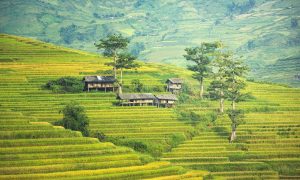This year marks the 45th anniversary of the establishment of diplomatic relations between South Korea and Myanmar. Over the past few years of cooperation, the two countries have seen growing connections in all spheres; the ever-increasing South Korean investment in Myanmar clearly attests to this. South Korea is currently the sixth-largest investor in Myanmar, and its investment will likely continue under the banner of the New Southern Policy — President Moon Jae-in’s signature foreign policy initiative — which aims to elevate South Korea’s ties with ASEAN and its member states, including Myanmar.
Among many business sectors, it is notable that a considerable amount of South Korea’s investment has heavily focused on Myanmar’s manufacturing businesses, primarily the garment industry. Needless to say, the role of the garment industry is immense in Myanmar’s economic landscape. According to data provided by Myanmar’s Ministry of Commerce, export earnings from garment businesses greatly reduced the country’s current account deficit, from $3.9 billion in the 2017–2018 fiscal year to $1.14 billion in the 2018–2019 fiscal year. South Korea’s intensive investment in Myanmar’s manufacturing sector, which is best represented by more than 100 Korean garment factories operating in Myanmar, has been a win–win situation for both countries; South Korea was able to utilize cheaper labor costs and Myanmar benefitted from the job creation effect and robust export growth.
Nevertheless, with the global health crisis of COVID-19 looming over Myanmar, the manufacturing sector — including the garment industry — may no longer remain the engine of the country’s economic growth in the near future. Aside from the drastic decline in global trade and its financial impact on the domestic market, Myanmar authorities are also concerned about the reality that a certain level of physical contact between laborers is inevitable in factories, which could lead to the mass spread of contagions like the new coronavirus. With this in mind, Myanmar would prefer to eventually shift its economic driver to an industry that has a low risk of viral infection but that can also generate significant economic benefits.
Thus the question arises as to which sector Naypyitaw should direct its available resources toward in order to propel the country’s economy. At this point, it is important to examine the composition of Myanmar’s GDP. The “Myanmar Economic Monitor” published by the World Bank Group in December 2019 states that the agricultural sector accounts for 24 percent of Myanmar’s GDP, while the industrial (37 percent) and service (39 percent) sectors take up the rest. These figures suggest that Myanmar — traditionally an agriculture-based country — has been preparing for industrial structure transition. In her opening address at the 2018 World Economic Forum on ASEAN, State Counsellor Aung San Suu Kyi even described this transition as “leap-frogging from line phones to a 4G network.” Nonetheless, as the spread of COVID-19 hit the industrial and service sectors where employee–employee and employee–customer contact are essential, Myanmar should reconsider its economic development strategy and ponder how to take advantage of its strengths in agriculture, which remains the largest sector for jobs, employing 70 percent of its population. This is even more relevant as Myanmar’s exports of agricultural produce are rapidly increasing, earning more than $2.8 billion over the past eight months.
In the light of these considerations, just as Myanmar has teamed up with South Korea in its manufacturing sector, much the same can also be done in agriculture. In fact, South Korea has shown strong interest early on in cooperating with Myanmar in the field of agriculture. In 2014–2019, one key project of Korea’s International Cooperation Agency (KOICA) in Myanmar was the “Saemaul Undong Project,” also known as the “New Village Movement.” With a total budget of $22 million, this project focused on income generation and developing the capacity of rural communities by adapting the Korean rural development model to the Myanmar context. In addition, KOICA recently completed another project to establish an “Integrated Agriculture and Irrigation Department Masterplan” in the Irrawaddy Delta Region, Myanmar’s largest granary with the highest rice production. Furthermore, the Korea Program on International Agriculture (KOPIA) also periodically dispatches staff to Myanmar for agricultural research purposes.
From all this, it should be clear that South Korea has the will and expertise for agricultural cooperation with Myanmar. South Korea teaming up with Myanmar in this field is mutually beneficial for many reasons. For South Korea, whose grain self-sufficiency rate stands at just 24 percent, enhancing agricultural cooperation with Myanmar is a great strategy to guarantee its food security in this age of the pandemic. Meanwhile, partnering up with South Korea will bring Myanmar advances in farming technology, leading to higher crop productivity and poverty reduction. Moreover, by expanding the scope of cooperation with South Korea, Naypyitaw will be able to offset the political concern — raised by many experts at home and abroad — that its economy is overly dependent on China. This political burden may be alleviated by diversifying export–import markets; this could be in the current NLD administration’s favor in the upcoming 2020 Myanmar general election.
For all the reasons above, it is reasonable to conclude that South Korea–Myanmar economic relations, which have been strengthened through solid partnerships in the manufacturing sector, have the potential to also be broadened in agriculture. In this unprecedented age of the COVID-19 pandemic, South Korea and Myanmar — now more than ever — should not risk losing any opportunity to closely work together to develop greater economic resilience against future crises.
Sinmyung Park holds an MSc. International Relations from the London School of Economics and Political Science (LSE) and will enroll for the Justice Studies doctoral program in the fall at Arizona State University’s School of Social Transformation. He is a former political researcher at the Embassy of the Republic of Korea in the Republic of the Union of Myanmar.

































